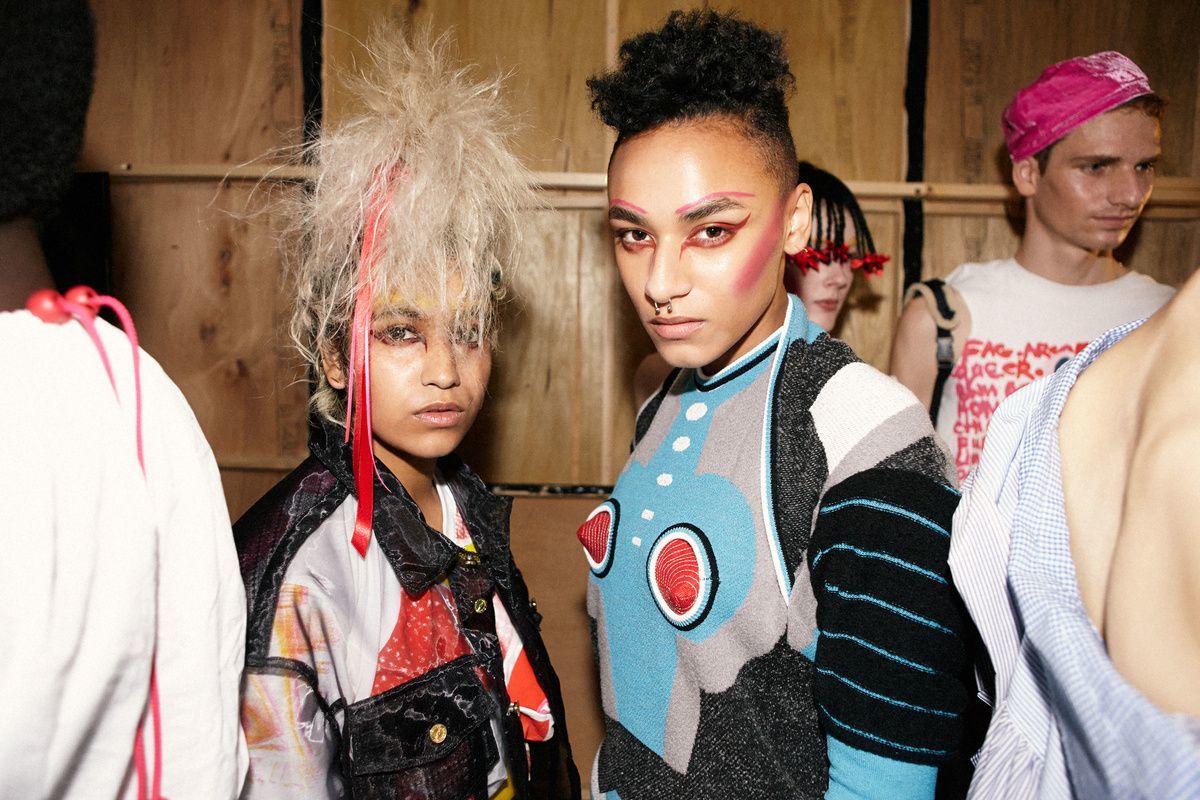When I was featured in the i-D x Business of Fashion #BOF500 film, I said something on camera that was singled out and duly lambasted on i-D’s Instagram. “The fashion industry is about creativity first and foremost and hopefully commerce second.” Commenters flagged up my naivety and deemed I was living in a la-la land. Maybe I am but when you’re facing up to the reality of a fashion industry which crushes creativity, I’d rather keep my rose-tinted glasses on. That’s exactly what has happened as it was revealed on Style.com in an interview with Maya Singer that Meadham Kirchhoff won’t be staging a show as part of London Fashion Week next season, with the reason being that they don’t have the funds to do so. They haven’t officially said it’s the end but it certainly feels like it’s nigh.
Ed Meadham and Ben Kirchhoff need no introduction. Ever since they began on their quest on discovering the Cosmology of Women, the industry has been in their thrall and ever-eager to be swept under their spell of fantastical dreamer fashion. They reached a pinnacle when they presented raging Courtney Love’s in satin dresses and ballerinas in fanciful fluff and frou-frou in their spring/summer 12 collection named A Wolf in Sheep’s/Lamb’s Clothing. Above any surface-driven aesthetic, it’s the don’t-give-a-fuck spirit inherited from London’s premier fashion provocateurs (Westwood, Bodymap, Galliano etc) that garnered Meadham Kirchhoff a diehard fanbase – one that turns up in their hundreds outside their Hackney studio for a chance to be street-cast in their fashion shows or grab a piece of discounted MK. They’re girls and boys around the world Tumblr-ing their love for Meadham Kirchhoff through moodboards, collages and emojis. I’ve literally seen people go misty-eyed and enter trance-like states when the subject of Meadham Kirchhoff comes up. For those that get it, the love runs deep.
At Meadham Kirchhoff’s recent sample sale, rails were stuffed with archive pieces. It was a clear out of epic proportions and it felt like precious pieces of Meadham and Kirchhoff were going for a song. You can immediately debunk that myth that the duo are maverick conceptualists who make unwearable clothes once you’ve copped a feel of their pin-tucked chiffon dresses with intricate cutwork or embroidered peasant blouses that are finished by hand. Every time I’ve worn something by Meadham Kirchhoff, people will invariably comment on how beautiful and lovely it is and then look slightly perplexed when I tell them who it’s by. Selling has never been a problem either as they told Style.com openly that they sold everything they made and tellingly, their collaboration with Topshop last year also sold out in minutes.
So how does a label that has feverish fandom and beautiful and desirable product, find itself unable to carry on? Louise Gray, a former kindred spirit on the London fashion scene also succumbed to the pressures of being out alone on the island of idiosyncratic creatives. On one hand you could say that perhaps the audience of these designers are niche and small. And if they have enjoyed longstanding support sponsorship from schemes like New Gen and still can’t make it work, then the problem lies with their collections.
On the other hand, maybe we should think about whether a one size fits all fashion system works for every single designer out there. Are the pressures of bottom lines in department stores and boutiques restricting the breadth of their buys? Are the number of collections required of designers fatigueing an industry – where the truly sublime can pass people by in a flash because our attentions are so diverted and divided? For all the strides that London Fashion Week has made in recent seasons, are we still succumbing to the same pitfalls of the 80s and 90s where support out there for designers who aren’t necessarily business minded is lacking? Hungry press and retailers demand shows to drum up hype and hub-hub, but when they are so costly and take out so much resources from young designers and start-ups, why not use alternative modes of presentation and communication? And in an age where boundaries are removed through the internet, can a brand like Meadham Kirchhof with such a fervent following reach out to their customers directly, cutting out the middlemen?
Meadham Kirchhoff and Gray’s demise is further evidence of a fashion industry where taste has been quashed through a conventional and ultra polite filter. Everything needs to be instantly sellable, commercial and anything remotely madcap won’t go the distance or even make it to the rails. And yet we still dance under the masquerade of an industry that promotes the new, the exciting and the innovative. Their disquiet of this ruthless industry was expressed in their bolshy and anger-driven spring/summer 2015 collection. It was two fingers up at the establishment. In an interview in i-D’s The Future Fashion Issue, Kirchhoff was lucid about designers today that have to bend over backwards to meet the needs of the industry. “I think you have a culture of designers at the moment that is about pleasing the journalists and the buyers and saying yes to everything,” he confessed.
Still, perhaps there’s a different outlet for these maverick creative out there. Gray is currently teaching and has also been working with Lulu Kennedy on Lulu & Co. Could there be a house out there for Meadham and Kirchhoff where the financials are in place to put their talent and skills to good use?
Until solution are found, I lament the dearth of “difficult” designers – as in their clothes might be tricksy or their characters tempestuous. Everything comes too easy with Instagram-able personas and rack-ready product. This isn’t the industry that I fell in love with. I’d rather be in la-la land than a no-man’s land of drone-like fashion and conveyor belt creativity. We need to be careful that we don’t eradicate the very reason that made us do what we do.
Credits
Text Susie Lau
Photography Piczo
